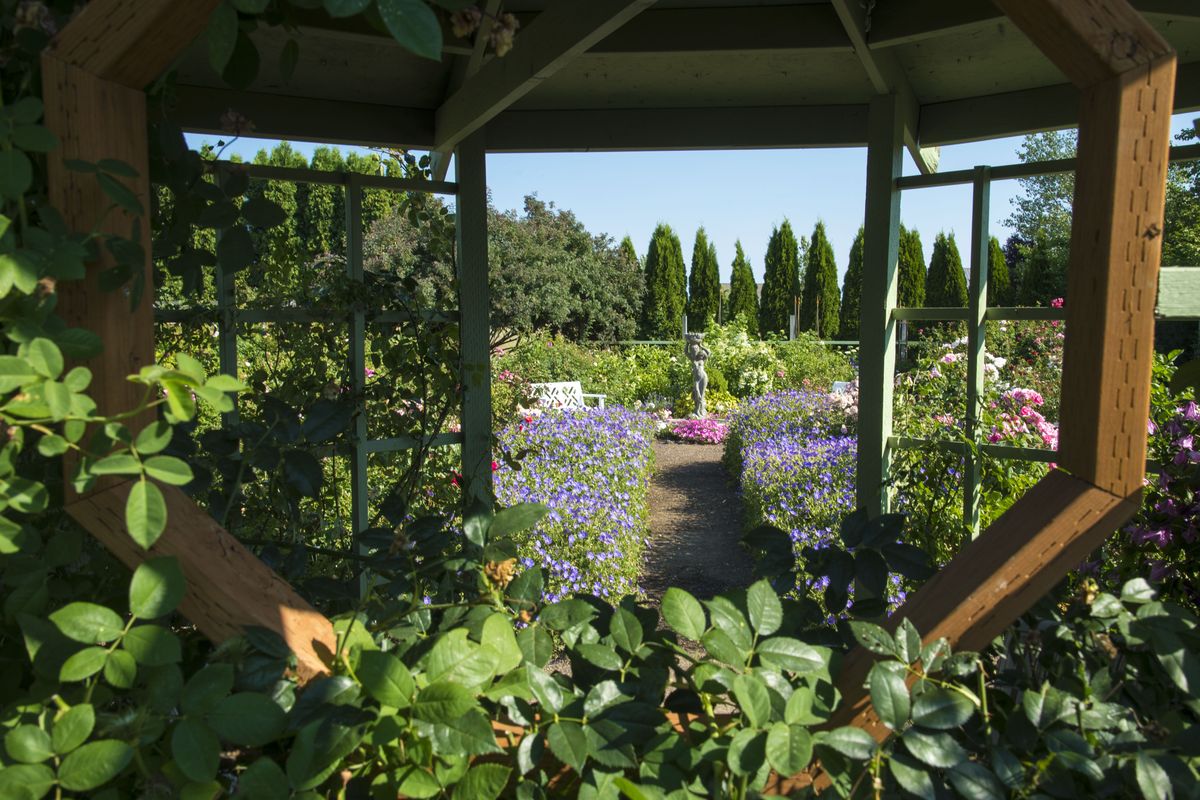Northland Rosarium owner found inspiration abroad for her gardens

When you hear the words “English garden,” many pictures come to mind. After all, we Americans have been fascinated with them for centuries.
Carol Newcomb has been to England twice and her mind is filled with many beautiful images of the gardens she has toured. As owner of Northland Rosarium in southwest Spokane County, she was particularly interested in seeing roses but was instantly taken with everything she saw in those gardens.
“For me, the term ‘English garden’ brings to mind a glorious lushness, edged by borders of boxwood, wonderful vistas edged in blue flowers, and roses on arches, arbors and trellises,” she said.
In “America’s Romance with the English Garden” (Ohio University Press, 271 pages, $26.95), author Thomas J. Mickey describes the English garden this way:
“Its landscape includes a lawn, carefully sited trees and shrubs, individual garden beds with native and exotic plants, and perhaps, out back, a vegetable or kitchen garden. The lawn and the use of exotic plants are relics of the English garden style we have loved for the past two hundred years.”
On her second trip to England, Newcomb joined a group of rose enthusiasts and visited 16 iconic rose gardens in 10 days. That trip had a major influence on the display gardens at Northland Rosarium.
“Mottisfont Abbey was one of my favorite English gardens. It houses a collection of old garden roses and David Austin English roses,” she said recently. “Each garden was very different, but the use of borders, walls and fences to contain the garden is very much a part of English gardening, along with dramatic entrances and vistas.”
Enclosed areas within each garden create “rooms” that can be very different in character from one another and add excitement to the garden.
“They offer a surprise each time you round a corner,” Newcomb said. “You wouldn’t think a garden could be any more beautiful, but then you enter a new room and discover that is indeed the case.”
At Northland Rosarium, a massive brick wall wasn’t in her budget, so she has used conifers, deciduous trees, hedges and shrubs instead to define different areas of the garden.
Back in England, flower borders are frequently edged with neatly clipped boxwood hedges.
“The English tend to anchor their gardens with some type of formal structure – whether it is with shrubs, hedges or topiary – and then plant riotously all around it with all sorts of flowering perennials,” Newcomb explained. “It’s the border that makes everything look organized.”
Wide flower beds are planted profusely with a variety of plants. Roses, lavender, hardy geraniums, bellflowers (Campanula) and catmint (Nepeta) are frequently used.
“When we visited Mottisfont Abbey, I looked through the brick archway into the garden, and all I could see was a blue path inviting me to enter,” Newcomb said. “That blue came from wide plantings of Pritchard’s Variety campanulas. It has been a vivid memory and we have tried to copy that in our garden.”
Other staples of the English garden are structures covered with clematis vines, climbing roses or rambling roses.
In old English gardens, coleus, Joseph’s Coat (Alternanthera) and other annuals with unusually colored foliage were common sights in flower borders. Other popular annuals were lobelia and ageratum, and exotic plants like orchids and ferns were highly sought after. Today, many different types of annuals are available to gardeners for inclusion in flower beds.
“In addition to the perennial plantings, annuals are wonderful plants for filling in with color while the roses are resting up for their fall bloom,” Newcomb said. “Anything with beautiful foliage and wonderful flowers is perfect.”
And last but not least, water features play a key role in an English garden. Glass houses containing water lily gardens were common features of 19th century English gardens and can be seen at places like London’s Kew Gardens today.
“Water is definitely an important element,” Newcomb said. “Every garden we visited had some sort of water feature. We saw fountains, ponds and statuary with splashing water so we’ve added some to our display gardens as well.”